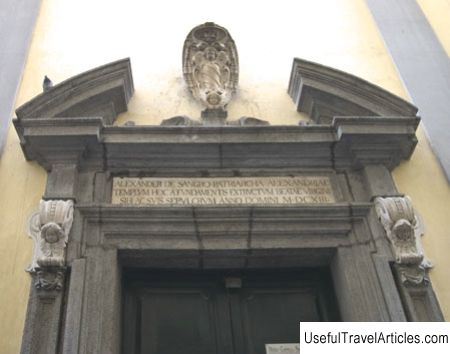Chapel of San Severo in Italy, Naples resort
Rating: 7,8/10 (300 votes)  The Chapel of San Severo in the past was a private chapel and burial vault of the noble Sangro family, who bore the title of San Severo. Today, the chapel houses famous sculptural masterpieces of the 18th century – `` Chastity '', `` Christ under the Shroud '' and 'Getting rid of the spell.' There are also numerous tombstones made of marble, which are allegories of various virtues. The chapel is located in the central part of Naples near the temple of San Domenico Maggiore. Nowadays, the chapel is a museum. The chapel was erected in 1590 on the territory of the Sangro family estate. The chapel is a votive temple built in honor of two miracles that originated from the image of the Virgin `` Pieta. The first miracle was mentioned in the book of Cesare d'Engenio Caracciolo: a certain man in chains passed by the house of Sangro, who was innocently accused. He noticed that part of the garden wall was crumbling, and immediately an image of the Virgin appeared in its place. Shocked by the conduct, the prisoner vowed to present a silver medallion to this image in case of his acquittal. Soon this man was acquitted and he fulfilled his vow. Later, a second miracle happened: Giovanni Francesco Paolo de Sangro was healed by praying this image. As a token of gratitude, he built a small chapel on the site of the apparition. At the beginning of the 17th century, the chapel was enlarged by the son of the chapel builder Alessandro – Titular Patriarch of Alexandria and Archbishop of Benevento, who also reburied the remains of some ancestors in it. In 1613, the patriarch consecrated the chapel and built a tomb here for the members of the Sangro family. In 1749-1767, a number of reconstruction works were carried out in the chapel, during which it acquired its present appearance. All work on the reconstruction and interior decoration of the chapel was supervised by Raimondo de Sengro. Also, in addition to the burials of parents and ancestors, Raimondo arranged tombs in the building for himself, his son and his daughter-in-law. The chapel is a one-nave building without an apse. Each of the `` long '' the sides of the chapel are adorned with four graceful arches that frame the altar or monumental tomb. The altar part is distinguished from the total volume of the chapel by a triumphal arch resting on two pylons. The marble floor of the chapel was replaced with terracotta in the 19th century. The vault of the temple is presented in the form of a huge fresco `` Heavenly Glory '' by Francesco Maria Russo. The ceiling above the main altar is made in the form of an illusion, popular in the XVII – XVIII centuries – 'false dome'. The chapel also contains lesser-known monuments and gravestones XVII – XVIII centuries, such as the monument to Cecco de Sangro, `` Decency '', `` Generosity '', `` Religious zeal '', `` The sweetness of the marriage bond '', `` Composure '', `` Sincerity '' and 'Divine love'. We also recommend reading Church of Santa Maria della Salute in Italy, Venice resort Topic: Chapel of San Severo in Italy, Naples resort. |




